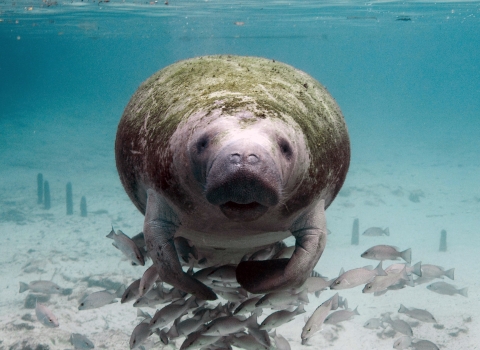RED BLUFF, California – Wildlife and water management officials are heralding the early returns of a special group of winter-run Chinook salmon this spring to the Coleman National Fish Hatchery on Battle Creek near Red Bluff along the Sacramento River.
As of today, 13 fish that were released into Battle Creek a year ago to journey to the ocean have found their way back to the hatchery. These fish were among 214,000 juveniles released last spring as part of a jump start program aimed at bolstering the endangered fish’s population after extreme drought in 2014 and 2015 nearly wiped out the entire in-river juvenile population.
The fish that have returned so far this year are early achievers – most winter-run take two to three years to make their way back to breeding areas, and officials say the fact that some are showing up this year is a good sign.
“It’s a hard life for a juvenile salmon from release until return and it’s always exciting to see that they have made it back,” said Jim Smith, project leader for the Red Bluff office of the U.S. Fish and Wildlife Service. “This is a significant step towards success of expanding the current range of endangered winter-run Chinook salmon and in the recovery of this unique species.”
“We are excited to see the early implementation of this important recovery action for winter-run is yielding such promising results so soon,” said Howard Brown, NOAA Fisheries biologist for the California Central Valley Office. “We are hopeful that seeing these early-returning fish this year is an indication of what we might expect to see when three-year old fish start arriving next year.”
North Fork of Battle Creek is historic habitat for winter-run Chinook salmon. Resource managers from the Battle Creek Salmon and Steelhead Restoration Program, comprised of the California Department of Fish and Wildlife, the U.S. Fish and Wildlife Service, Bureau of Reclamation and NOAA Fisheries, and Pacific Gas and Electric Company, have invested more than $100 million since 1999 to restore about 48 miles of prime salmon and steelhead habitat.
“This is a promising sign for reintroduction of endangered winter-run into Battle Creek,” said California Department of Fish and Wildlife Fisheries Branch Chief Kevin Shaffer. “We are looking forward to completion of restoration projects in the watershed, which will allow these fish to migrate to and thrive in the headwaters of upper Battle Creek.”
“Returns of winter-run Chinook in the Sacramento River used to be as high as nearly 100,000 fish in the 1960s and supported a healthy in-river fishery,” said Smith. “Recovery of this run is important to eventually reestablish this fishery. Other runs of salmon can also benefit from a recovered winter-run population, since these other salmon fisheries have been reduced to protect the winter-run salmon that mingle together in the ocean.”
The confirmed returnees are all male two-year-old fish. Winter-run usually return as three-year-olds, so additional returns are expected next year from the 2018 release. Juvenile releases in 2018 and 2019 are from captive brood stock spawned at Livingston Stone National Fish Hatchery in 2017 and 2018. The eggs and fry were transferred to Coleman and raised for about five months before being released into Battle Creek.
For more information, please see:
https://www.fws.gov/cno/newsroom/highlights/2019/winter-run-2019/
https://www.fws.gov/cno/newsroom/featured/2018/battle_creek/
The U.S. Fish and Wildlife Service works with others to conserve, protect, and enhance fish, wildlife, plants, and their habitats for the continuing benefit of the American people. For more information about our work and the people who make it happen, visit https://www.fws.gov/cno/
or connect with us via Facebook, Twitter, YouTube, and Flickr.
-FWS-


